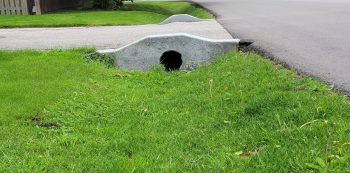
Ditches are linear, sodded excavations made in the ground to capture, convey and drain stormwater runoff (i.e. a storm drain system). In Toronto, ditches are commonly found along roadways in traffic corridors, residential and industrial areas. One identifying characteristic of ditched roads, aside from the ditch itself, are culverts (open metal pipes) under intersecting driveways to enable continuous flow of water. There are approximately 400 kilometres of roads with ditches across the city.
The most common alternative to a ditch system is an underground sewer system. In parts of the city, ditches are exclusively used to manage road runoff, while in others, an underground sewer system or a mixture of both are used.
A functional ditch system drains stormwater off impermeable surfaces in the City-owned right-of-way (i.e. paved portion of roadways and sidewalks) and helps to move the stormwater to local ravines and watercourses (i.e. creeks, streams and rivers). The sodded areas of ditched roads also offer ecological and hydrological benefits.

The main objective of a roadside ditch is to safely transport runoff from the City’s right-of-way to a watercourse (i.e. creeks, streams and rivers). This type of proper diversion and drainage of rain and snowmelt protects the integrity of the underlying road structure and surrounding structures.
Compared to an underground sewer system, ditches provide the following ecological and hydrological benefits to the local watershed, as runoff flows through ditches, soil, sod and other vegetation:
Over time, ditches may naturally fill with sediment and cease to function properly. When ditches fail to function properly, stormwater may cause surface flooding. In addition, water may pool on roadways, causing the asphalt to crack and potholes to form. In some cases, developers, property owners or landscapers have filled in ditches for aesthetic purposes, which also limits their functionality.
To help maintain the ditch in front of your property, you can:
Refer to By-law 743-36 property owner responsibilities for complete details.
When undertaking Capital Construction projects, such as road resurfacing, road reconstruction or basement flooding mitigation, the City will reinstate ditches in accordance with road design guidelines, which account for the safety of all road users.
This work involves:
During the winter months, the City’s Winter Operations Program keeps roads safe and passable. Every year, prior to the winter season, salt truck and snowplough operators complete a dry run of their routes to ensure they are familiar with the roads and note any changes to roads from the previous winter, including changes to ditches.
Learn more about Winter Road Maintenance.
For pedestrian and motorist safety, ditches are designed with a grading that allows adequate road drainage. Since road drainage is directed towards the ditches, the City is unable to install physical barriers between the road and ditch.
When walking or driving, exercise caution and be mindful of grade changes near ditches, especially during inclement weather and during the winter season.
Contact 311 if you identified a ditch as a trip/fall hazard.